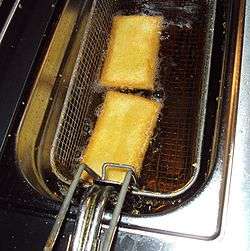Fried chicken
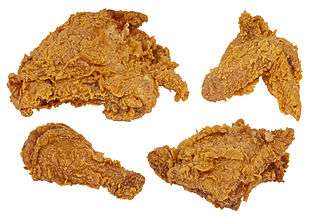 A chicken breast, wing, leg and thigh fried | |
| Course | Main meal |
|---|---|
| Serving temperature | Hot or cold |
| Main ingredients | Chicken |
|
| |
Fried chicken (also referred to as Southern fried chicken for the variant in the United States) is a dish consisting of chicken pieces usually from broiler chickens which have been floured or battered and then pan-fried, deep fried, or pressure fried. The breading adds a crisp coating or crust to the exterior. What separates fried chicken from other fried forms of chicken is that generally the chicken is cut at the joints, and the bones and skin are left intact. Crisp well-seasoned skin, rendered of excess fat, is a hallmark of well made fried chicken.
The first dish known to have been deep fried was fritters, which were popular in the Middle Ages. However, it was the Scottish who were the first Europeans to deep fry their chicken in fat (though without seasoning). Meanwhile, a number of West African peoples had traditions of seasoned fried chicken (though battering and cooking the chicken in palm oil). Scottish frying techniques and West African seasoning techniques were combined by enslaved Africans and African-Americans in the American South. Prior to the Second World War, fried chicken was often very expensive and was only enjoyed on special occasions. In the late 1900s and early 2000s, however, fried chicken has been mass-produced and the price of the dish has gone down significantly.
When being cooked, fried chicken is often divided into smaller pieces. The chicken is then generally covered in a batter, often consisting of ingredients such as eggs or milk. This is used to create a crust on the exterior of the meat. In addition, seasoning is often added at this stage. Once the chicken is ready to be cooked, it is placed in a deep fryer, frying pan or pressure cooker (depending on the method used) and fried in lard or a type of oil.
The dish has created a large number of spin-off recipes which are commonly used around the world. For example, Korean fried chicken, a dish which is commonly served as fast food in Korea and is known for being crispier than normal fried chicken. There is also a racial stereotype surrounding fried chicken and African-American people, mostly because it was popular among slaves in the American Civil War.
History
Both Scottish[1][2][3] and West African cuisines[4][5][6][7][8] had traditions of frying chicken.[1][2][3][4][5][6][7][8] Scottish fried chicken was cooked in fat (though unseasoned)[1][3] while West African fried chicken was seasoned[1][2][8] (but battered[5][6] and cooked in palm oil).[4] Scottish frying techniques and African seasoning techniques were in the American South by African slaves.[1][2][3][8] Fried chicken provided some means of independent economy for enslaved and segregated African-American women, who became noted sellers of poultry (live or cooked) as early as the 1730s.[9] Because of this and the expensive nature of the ingredients, it was, despite popular belief, a rare dish in the African-American community[4] reserved (as in Africa) for special occasions.[6][7][8]
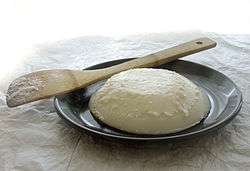
After the development of larger and faster-growing hogs (due to crosses between European and Asian breeds) in the 18th and 19th century in the United States, backyard and small-scale hog production provided an inexpensive means of converting waste food, crop waste, and garbage into calories (in a relatively small space and in a relatively short period of time). Many of those calories came in the form of fat and rendered lard. Lard was used for almost all cooking and was a fundamental component in many common homestead foods (many that today are still regarded as holiday and comfort foods) like biscuits and pies.[10] The economic/caloric necessity of consuming lard and other saved fats may have led to the popularity of fried foods, not only in the US, but worldwide.[11] In the 19th century cast iron became widely available for use in cooking. The combination of flour, lard, a chicken and a heavy pan placed over a relatively controllable flame became the beginning of today's fried chicken.
When it was introduced to the American South, fried chicken became a common staple. Later, as the slave trade led to Africans being brought to work on southern plantations, the slaves who became cooks incorporated seasonings and spices that were absent in traditional Scottish cuisine, enriching the flavor.[12] Since most slaves were unable to raise expensive meats, but generally allowed to keep chickens, frying chicken on special occasions continued in the African-American communities of the South. It endured the fall of slavery and gradually passed into common use as a general Southern dish. Since fried chicken traveled well in hot weather before refrigeration was commonplace, it gained further favor in the periods of American history when segregation closed off most restaurants to the black population. Fried chicken continues to be among this region's top choices for "Sunday dinner". Holidays such as Independence Day and other gatherings often feature this dish.[13]
Since the American Civil War, traditional slave foods like fried chicken, watermelon, and chitterlings have suffered a strong association with African-American stereotypes and blackface minstrelsy.[12] This was commercialized for the first half of the 20th century by restaurants like Sambo's and Coon Chicken Inn, which selected exaggerated depictions of blacks as mascots, implying quality by their association with the stereotype. Although also being acknowledged positively as "soul food" today, the affinity that African-American culture has for fried chicken has been considered a delicate, often pejorative issue.[14] While the perception of fried chicken as an ethnic dish has been fading for several decades, with the ubiquity of fried chicken dishes in the US, it persists as a racial stereotype.[15][16]
Before the industrialization of chicken production, and the creation of broiler breeds of chicken, only young spring chickens (pullets or cockerels) would be suitable for the higher heat and relatively fast cooking time of frying, making fried chicken a luxury of spring and summer. Older, tougher birds require longer cooking times at lower temperatures. To compensate for this, sometimes tougher birds are simmered till tender, allowed to cool and dry, and then fried. (This method is common in Australia.) Another method is to fry the chicken pieces using a pan fried method. The chicken pieces are then simmered in liquid, usually, a gravy made in the pan that the chicken pieces were cooked in. This process (of flouring, frying and simmering in gravy) is known as "smothering" and can be used for other tough cuts of meat, such as swiss steak. Smothered chicken is still consumed today, though with the exception of people who raise their own chickens, or who seek out stewing hens, it is primarily made using commercial broiler chickens.[12]
Description

Fried chicken has been described as being "crunchy" and "juicy",[17] as well as "crispy".[18] In addition, the dish has also been called "spicy" and "salty".[19] Occasionally, fried chicken is also topped with a chili like paprika, or hot sauce to give it a spicy taste.[20] This is especially common in fast food restaurants and chains such as KFC.[21] The dish is traditionally served with mashed potato, gravy, coleslaw and biscuits.[22]
The dish is renowned for being greasy and unhealthy, especially when coming from fast food outlets.[17] It has even been reported that some of those who enjoy eating the food limit themselves to eating it only a certain number of times a year, to keep their fat intake reasonably low.[23] Out of the various parts of the animal used in fried chicken, the wings generally tend to contain the most fat, with almost 40 grams (0.088 lb) of fat for every 100 grams (0.22 lb).[24] However, the average whole fried chicken contains only around 12% fat, or 12 grams (0.026 lb) per every 100 grams (0.22 lb).[25] As well as this, 100 grams (0.22 lb) grams of fried chicken generally contains around 240 calories of energy.[25]
One of the main causes of the large amounts of fat which can be found in fried chicken is the oil which is used to cook it. Vegetable oil, one of the most common oils used to cook fried chicken and other fried foods, consists mainly of fat and a large number of calories.[26]
Preparation
Generally, chickens are not fried whole; instead, the chicken is divided into its constituent pieces.[27] The two white meat sections are the breast and the wing from the front of the chicken, while the dark meat sections are the thigh and leg or "drumstick", are from the rear of the chicken. These pieces are usually subdivided into the wings, the breasts (the wishbone is often cut out first in home cooking), the legs, and the thighs. The ribs are sometimes left on the breast, but commercially they and the back are usually discarded.[28]
To prepare the chicken pieces for frying, they may be coated in a batter of flour and liquid (and seasonings) mixed together.[29] The batter can contain ingredients like eggs, milk, and leavening. Alternatively, they may be dredged in flour or a similar dry substance, to coat the meat and to develop a crust. Seasonings such as salt, pepper, cayenne pepper, paprika, garlic powder, onion powder, or ranch dressing mix can be mixed in with the flour. Either process may be preceded by marination or by dipping in milk or buttermilk. As the pieces of chicken cook, some of the moisture that exudes from the chicken is absorbed by the coating of flour and browns along with the flour, creating a flavorful crust.[30] According to Nathan Bailey's 1736 cookbook, Dictionarium Domesticum, for example, the chicken can be covered in a marinade that consists of the juice of two large fresh lemons, malt vinegar, bay leaves, salt, pepper, ground cloves, and green onions; it then must be settled in the marinade for three hours before being dipped in the batter that consists of all-purpose flour, white wine, three egg yolks and salt, and then slowly submerged in a deep pot of either oil, lard, or clarified butter over an open fire. It can then be topped with fresh, dried parsley dipped in the same frying oil.[31][32]
Traditionally, lard is used to fry the chicken, but corn oil, peanut oil, canola oil, or vegetable oil are also frequently used (although clarified butter may be used as well like in colonial times[31][32]). The flavor of olive oil is generally considered too strong to be used for traditional fried chicken, and its low smoke point makes it unsuitable for use.[33] There are three main techniques for frying chickens: pan frying,[34] deep frying[35] and broasting.[36]
Pan frying (or shallow frying) requires a frying pan of sturdy construction and a source of fat that does not fully immerse the chicken.[37] The chicken pieces are prepared as above, then fried. Generally the fat is heated to a temperature hot enough to seal (without browning, at this point) the outside of the chicken pieces. Once the pieces have been added to the hot fat and sealed, the temperature is reduced. There is debate as to how often to turn the chicken pieces, with one camp arguing for often turning and even browning, and the other camp pushing for letting the pieces render skin side down and only turning when absolutely necessary. Once the chicken pieces are close to being done the temperature is raised and the pieces are browned to the desired color (some cooks add small amounts of butter at this point to enhance browning). The moisture from the chicken that sticks and browns on the bottom of the pan become the fonds required to make gravy.[38]
Deep frying requires a deep fryer or other device in which the chicken pieces can be completely submerged in hot fat. The process of deep frying is basically placing food fully in oil and then cooking it at a very high temperature.[37] The pieces are prepared as described above. The fat is heated in the deep fryer to the desired temperature. The pieces are added to the fat and a constant temperature is maintained throughout the cooking process.[39]
Broasting uses a pressure cooker to accelerate the process.[40] The moisture inside the chicken becomes steam and increases the pressure in the cooker, lowering the cooking temperature needed. The steam also cooks the chicken through, but still allows the pieces to be moist and tender while maintaining a crisp coating. Fat is heated in a pressure cooker. Chicken pieces are prepared as described above and then placed in the hot fat. The lid is placed on the pressure cooker, and the chicken pieces are thus fried under pressure.[41]
The derivative phrases "country fried" and "chicken fried" often refer to other foods prepared in the manner of fried chicken. Usually, this means a boneless, tenderized piece of meat that has been floured or battered and cooked in any of the methods described above or simply chicken which is cooked outdoors. Chicken fried steak and "country fried" boneless chicken breast are two common examples.[42]
Global variants
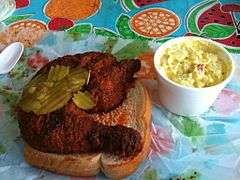
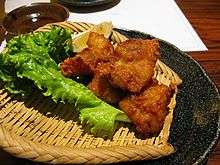
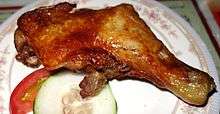
Throughout the world, different seasoning and spices are used to augment the flavor of fried chicken. Because of the versatility of fried chicken, it is not uncommon to flavor the chicken's crisp exterior with a variety of spices ranging from spicy to savory.[43][44] Depending on regional market ubiquity, local spice variations may be labeled as distinct from traditional Southern U.S. flavors, or may appear on menus without notation. With access to chickens suitable for frying broadening on a global scale with the advent of industrialized poultry farming, many localities have added their own mark on fried chicken, tweaking recipes to suit local preferences.[45]
North America
- Barberton Chicken: also known as Serbian Fried Chicken, created by Serbian immigrants in Barberton, Ohio and has been popularized throughout Ohio.[46]
- Buffalo wings: Named for their place of origin, Buffalo, New York, this is one of the few kinds of fried chicken that is not traditionally battered before frying.[47]
- Buffalo strips, fingers, crisp wings and boneless wings: using the same cayenne-pepper sauce as Buffalo wings, these chicken products are battered before frying. See also: chicken fingers and chicken nuggets.[48]
- Chicken fingers: also known as chicken tenders or chicken strips, this is one of the most common forms of fried chicken, generally pieces of chicken breast (sometimes with rib meat) cut into long strips, breaded or battered dipped, and deep fried.[49]
- Chicken fries: chicken nuggets in the shape of French fries, popularized by the fast-food chains Burger King and KFC. These may also be referred to as chicken sticks.[50]
- Chicken Maryland, a form of pan-fried chicken, often marinated in buttermilk, served with cream gravy and native to the state of Maryland. The recipe spread beyond the United States to the haute cuisine of Auguste Escoffier and, after heavy modification, found a place in the cuisines of Britain and Australia.[51] The dish is made when a pan of chicken pieces and fat, as for pan frying, is placed in the oven to cook, for a majority of the overall cooking time, basically "fried in the oven".[41]
- Chicken nuggets: an industrially reconstituted boneless chicken product invented by Cornell poultry science professor Robert C. Baker in the 1950s.[52]
- Popcorn chicken: occasionally known as chicken bites or other similar terms, small morsels of boneless chicken, battered and fried, resulting in little nuggets that resemble popcorn.[53]
- Popcorn chicken is also occasionally topped with peanuts, or peanut sauce.[54]
- Chicken patties: breaded, fried patties of chicken meat used in sandwiches.[55]
- Country Fried Chicken: chicken meat that has been coated with flour or breaded, fried and served topped with country cream gravy. Related tangentially to Chicken fried steak.[56]
- Chicken and waffles, a combination platter of foods traditionally served at breakfast and dinner in one meal, common to soul food restaurants in the American South and beyond.[57]
- Hot chicken: common in the Nashville, Tennessee area, a pan-fried variant of fried chicken coated with lard and cayenne pepper paste.[58]
- Fried chicken sandwiches: a bun, biscuit or doughnut which is filled with fried chicken and assorted toppings, popular in Washington, D.C.[59]
Asia
- Ayam goreng: various kinds of Indonesian, Singapore and Malaysian dish of chicken deep fried in coconut oil, this Southeast Asian version is absent of batter and richer in spices.[60]
- Crispy fried chicken: a dish from the regional Cantonese cuisine of China.[61]
- Har Cheong Gai: a Singaporean chicken wings fried in a batter with fermented shrimp paste.[62]
- Chicken karaage: a Japanese marinated and fried method of preparing fried chicken.[63]
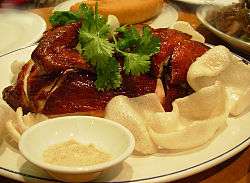 Crispy fried chicken served on a plate with prawn crackers
Crispy fried chicken served on a plate with prawn crackers - Salt and pepper chicken: (鹹酥雞 or 盐酥鸡) Cubes of chicken leg meat marinated and deep-fried, similar to karaage but flavoured with pepper salt and/or five-spice powder. Originating in Taiwanese night markets, it has also been popularized in North American Taiwanese bubble tea restaurants.[64]
- Taiwan fried chicken fillet: Chicken fillet prepared in a similar way to salt and pepper chicken, as one large piece eaten in a paper bag. Popular in Taiwanese night markets.[65]
- Chicken katsu: (チキンカツ), a Japanese panko-breaded, deep fried chicken cutlet, adapted from tonkatsu, a pork chop variant. Occasionally used in curry.[66]
- Korean fried chicken: (양념 치킨), fried chicken pieces flavored with Gochujang or ganjang based sauce with garlic.[67]
- Buldak: Spicy fried or barbecued chicken with Korean seasonings.[68]
- Prawn paste chicken or "shrimp paste chicken": popular in Hong Kong-style restaurants in Singapore and Malaysia. Incorporates puréed shrimp and ginger juice into its breading mixture.[69]
- Sweet and sour chicken: deep-fried balls of chicken breast in batter.[70]
- Toriten: Japanese tempura style fried chicken.[71]
- Chicken with chilies: (辣子鸡), a Sichuan-style dish with small deep-fried pieces of chicken that are then stir-fried with chilies.[72]
- Chicken lollipop: An Indian snack of fried chicken drumettes, coated in a spiced batter and fried.[73]
Racial stereotype
In the United States, fried chicken has stereotypically been associated with African-Americans.[74] The reasons for this are various. Chicken dishes were popular among slaves before the Civil War, as chickens were generally the only animals slaves were allowed to raise on their own.[75] Minstrel shows and the film The Birth of a Nation led to a prevalent stereotype associating African-Americans with fried chicken.[76]
On two occasions the golfer Tiger Woods has been the target of remarks regarding fried chicken.[77] The first occurred in 1997 when golfer Fuzzy Zoeller said that Woods should avoid choosing fried chicken for the Masters champions' dinner the following year;[78] the second when golfer Sergio García was asked in a press conference in 2013 whether he would invite Woods to dinner during the U.S. Open to settle their ongoing feud. García said: "We will have him round every night . . . We will serve fried chicken", which Woods said was "wrong, hurtful and clearly inappropriate".[78] Both Zoeller and García subsequently apologized to Woods.[78]
In 2009, a Bangladeshi immigrant to the U.S. renamed his restaurant "Obama Fried Chicken" in honor of recently inaugurated President Barack Obama.[79] Despite controversy at the time, the owner refused to change the name back, and the restaurant continues to operate under this name.[75]
At a dinner during Black History Month, an NBC chef, Leslie Calhoun, served fried chicken.[80] The drummer of the Roots, Questlove, was angered by this and thought it both offensive and ignorant.[81]
In 2012, Burger King withdrew a commercial which featured Mary J. Blige singing about a crispy chicken wrap. This was due to the racial stereotypes surrounding fried chicken.[82]
See also
References
- 1 2 3 4 5 Sumnu, Servet Gulum; Sahin, Serpil (December 17, 2008). Advances in Deep-Fat Frying of Foods. CRC Press. pp. 1–2. ISBN 9781420055597.
The origin of fried chicken is the southern states of America. Fried chicken had been in the diet of Scottish people for a long time, but they did not use seasoning. After African slaves had been hired as cooks, they added seasoning to the fried chicken of the Scottish people. Because slaves were allowed to feed only chickens, fried chicken became the dish that they ate on special occasions. This tradition spread to all African-American communities after the abolition of slavery.
- 1 2 3 4 Mariani, John F. (1999). The Encyclopedia of American Food and Drink. New York: Lebhar-Friedman. pp. 305–306.
The Scottish, who enjoyed frying their chickens rather than boiling or baking them as the English did, may have brought the method with them when they settled the South. The efficient and simple cooking process was very well adapted to the plantation life of the southern African-American slaves, who were often allowed to raise their own chickens.
quoted at Lynne Olver. "history notes-meat". The Food Timeline. Retrieved June 20, 2009.. - 1 2 3 4 Robinson, Kat (Oct 21, 2014). Classic Eateries of the Arkansas Delta. The History Press.
Most settlers from Europe were accustomed to having their chicken roasted or stewed. The Scots are believed to have brought the idea of frying chicken in fat to the United States and eventually into the Arkansas Delta in the eighteenth and nineteenth centuries. Similarly, African slaves brought to the South were sometimes allowed to keep chickens, which didn't take up much space. They flour-breaded their pieces of plucked poultry, popped it with paprika and saturated it with spices before putting it into the grease.
- 1 2 3 4 Rice, Kym S.; Katz-Hyman, Martha B. (2010). World of a Slave: Encyclopedia of the Material Life of Slaves in the United States [2 volumes]: Encyclopedia of the Material Life of Slaves in the United States. ABC-CLIO. pp. 109–110. ISBN 978-0-313-34943-0.
Chickens also were considered to be a special dish in traditional West African cuisine. ... Chickens were... fried in palm oil. ... Pieces of chicken fried in oil sold on the street ... would all leave their mark on the developing cuisine of the early South.
- 1 2 3 Kein, Sybil (2000). Creole: The History and Legacy of Louisiana's Free People of Color. LSU Press. pp. 246–247. ISBN 978-0-8071-2601-1.
Creole fried chicken is another dish that follows the African technique: "the cook prepared the poultry by dipping it in a batter and deep fat frying it
- 1 2 3 4 Opie, Frederick Douglass (2013). Hog and Hominy: Soul Food from Africa to America. Columbia University Press. p. 11. ISBN 978-0-231-51797-3.
West African women batter dipped and fried chicken" and "The African-American practice of eating chicken on special occasions is also a West Africanism that survived the slave trade. Among the Igbo, Hausa, and Mande, poultry was eaten on special occasions as part of religious ceremonies.
- 1 2 3 Opie, Frederick Douglass (2013). Hog and Hominy: Soul Food from Africa to America. Columbia University Press. p. 18. ISBN 978-0-231-51797-3.
..the African-American preference for yams and sweet potatoes, pork, chicken, and fried foods also originated in certain West African culinary traditions
- 1 2 3 4 5 Worral, Simon (December 21, 2014) "The Surprising Ways That Chickens Changed the World". National Geographic: "When slaves were brought here from West Africa, they came with a deep knowledge of the chicken, because in West Africa the chicken was a common farm animal and also a very sacred animal. The knowledge that African-Americans brought served them very well, because white plantation owners for the most part didn't care much about chicken. In colonial times there were so many other things to eat that chicken was not high on the list."
- ↑ Rice, Kym S.; Katz-Hyman, Martha B. (2010-12-13). World of a Slave: Encyclopedia of the Material Life of Slaves in the United States [2 volumes]: Encyclopedia of the Material Life of Slaves in the United States. ABC-CLIO. p. 109. ISBN 9780313349430.
- ↑ "10 Reasons You Should Be Cooking With Lard". The Huffington Post Australia. Retrieved June 3, 2016.
- ↑ "The TOP 3 reasons why YOU should be eating LARD". Weed 'em & Reap. Retrieved June 4, 2016.
- 1 2 3 History of Fried Chicken through the Ages. Southernfriedchickenrecipe.com. Retrieved on January 30, 2012.
- ↑ History of Fried Chicken : I Am Welcoming You to Kik Culinary Corner and History of Some Story & Experience. Experienceproject.com (August 19, 2008). Retrieved on 2012-01-30.
- ↑ Hook, Sara Anne (October 26–27, 2007). "Zip Coon and Watermelons: The Perpetuation of Racial Stereotypes through Visual Imagery from the 19th and Early 20th Centuries" (PPT). 32nd Annual Great Lakes History Conference. Retrieved June 20, 2009.
- ↑ "Earl Ofari Hutchinson: Atlanta Falcon's Owner Should Apologize For His Foot-in-the-Mouth Racial Slur About Michael Vick". Huffingtonpost.com. December 13, 2007. Retrieved June 20, 2009.
- ↑ "Miami Ethnic Clash May Preview U.S. Where 'Minorities' Dominate". Bloomberg.com. August 19, 2008. Retrieved June 20, 2009.
- 1 2 "Southern Living's Best Fried Chicken Recipe". NYT Cooking. Retrieved May 21, 2016.
- ↑ "Adobo-Fried Chicken Recipe". NYT Cooking. Retrieved May 21, 2016.
- ↑ Eats, Serious. "The Food Lab: The Best Southern Fried Chicken". www.seriouseats.com. Retrieved June 4, 2016.
- ↑ "Spicy Fried Chicken With Honey and Pickles". Wall Street Journal. January 9, 2014. ISSN 0099-9660. Retrieved May 21, 2016.
- ↑ Waxman, Olivia B. "KFC Introduces Nashville Hot Chicken". TIME.com. Retrieved May 21, 2016.
- ↑ Bruno, Pat (January 3, 1986). "Fried chicken worth clucking about". Chicago Sun-Times – via HighBeam (subscription required) . Retrieved September 4, 2016.
- ↑ Galarneau, Andrew Z. (March 9, 2011). "Chicken fried right ; When it's time to splurge, Buffalo has its share of restaurants serving crispy fried chicken". The Buffalo News – via HighBeam (subscription required) . Retrieved September 4, 2016.
- ↑ "Moisture and fat content Moisture and fat content of extra crispy fried of extra crispy fried chicken skin from breast, thigh, drum and wing" (PDF). ars.usda.gov. Retrieved May 21, 2016.
- 1 2 "Chicken, broilers or fryers, light meat, meat and skin, cooked, fried, flour". ndb.nal.usda.gov. Retrieved June 3, 2016.
- ↑ Revolution, Health Fitness (2015-01-15). "20 Reasons to Cut Out Fried Foods • Health Fitness Revolution". Health Fitness Revolution. Retrieved June 3, 2016.
- ↑ "How to Make the Best Fried Chicken – Cooking 101 – Cook's Country". www.cookscountry.com. Retrieved June 4, 2016.
- ↑ "Cutting Up Chicken – Kitchen Notes – Cooking For Engineers". www.cookingforengineers.com. Retrieved June 4, 2016.
- ↑ "Triple Dipped Fried Chicken Recipe". Allrecipes. Retrieved June 4, 2016.
- ↑ "The Science of Frying — FineCooking.com". FineCooking.com. Retrieved June 4, 2016.
- 1 2 Pereira, Alyssa (June 22, 2016). "The internet is obsessing over this 18th century fried chicken recipe". San Francisco Chronicle. Retrieved June 23, 2016.
- 1 2 Jas. Townsend and Son, Inc. (June 20, 2016). "Fried Chicken In The 18th Century?". YouTube. Retrieved June 23, 2016.
- ↑ What is Southern Fried Chicken?. Wisegeek.com. Retrieved on January 30, 2012.
- ↑ "Southern Pan-Fried Chicken Recipe". NYT Cooking. Retrieved May 21, 2016.
- ↑ "How to Make Thai-Style Deep Fried Chicken Thighs". Fox News Magazine. December 23, 2014. Retrieved May 21, 2016.
- ↑ "This chicken's not roasted, broiled or fried. It's BROASTED. Good luck finding it, though". Washington Post. Retrieved May 21, 2016.
- 1 2 "Pan Frying – Food Reference Cooking Basics – Food For Thought". www.foodreference.com. Retrieved June 4, 2016.
- ↑ "Deglazing: What it Is and Why Do It". The Reluctant Gourmet. September 14, 2012. Retrieved June 4, 2016.
- ↑ "How to deep-fry – How To Guides – Cooking tips". Taste.com.au. Retrieved June 4, 2016.
- ↑ "How to make homemade Broasted Chicken". Retrieved July 21, 2016.
- 1 2 Fried Chicken Recipes. Southernfood.about.com (November 9, 2011). Retrieved on 2012-01-30.
- ↑ "From John T. Edge: Chicken Fried Steak, Steamed Sandwiches, Georgia Barbecue". Diner's Journal Blog. The New York Times. Retrieved May 21, 2016.
- ↑ "Kentucky Fried Chicken Seasoning Mix Recipe - Deep-fried.Food.com". Retrieved July 18, 2016.
- ↑ Fowler, Damon Lee. "Herb-and-Spice Southern Fried Chicken". Epicurious. Retrieved July 18, 2016.
- ↑ Fried Chicken: All-American Favorite, Worldwide Style. Grandparents.com. Retrieved on January 30, 2012.
- ↑ Edge, John T. (Mar 2003). "The Barberton Birds". Attaché. Archived from the original on 2006-02-16.
- ↑ Horwitz, Jeremy (January 1, 2008). "Chicken Wings, or, Why people Know About Buffalo". Buffalo Chow.com. Retrieved November 18, 2009.
- ↑ "Buffalo Chicken Strips with Blue Cheese Salad Recipe | PBS Food". PBS Food. August 28, 2011. Retrieved May 18, 2016.
- ↑ Ramzy, Austin (May 5, 2016). "KFC, With New Nail Polish, Redefines Chicken Fingers". The New York Times. ISSN 0362-4331. Retrieved May 19, 2016.
- ↑ Basu, Tanya. "Burger King Introduces a Spicy Version of Its Chicken Fries". TIME.com. Retrieved 2016-05-19.
- ↑ "Maryland chicken with banana fritters and cornbread". BBC Food. Retrieved 2016-05-19.
- ↑ "McNugget makeover? McDonald's tests chicken nuggets without artificial additives". Fox News. 2016-04-28. Retrieved 2016-05-19.
- ↑ "Recipe: Devin Alexander's KFC's Popcorn Chicken". ABC News. April 26, 2006. Retrieved May 18, 2016.
- ↑ "Thai Popcorn-and-Peanut-Crusted Chicken". The Washington Post. July 21, 2013. Retrieved May 18, 2016.
- ↑ "Cumin-Cilantro Chicken Patties". Washington Post. Retrieved May 19, 2016.
- ↑ "Charles Country Pan Fried Chicken". Village Voice. Retrieved May 19, 2016.
- ↑ Myers, Dan (2015-10-27). "America's best chicken and waffles". Fox News. Retrieved May 19, 2016.
- ↑ Waxman, Olivia B. "KFC Introduces Nashville Hot Chicken". TIME.com. Retrieved May 19, 2016.
- ↑ "The ultimate guide to the best fried chicken sandwiches in the D.C. area". The Washington Post. March 29, 2016. ISSN 0190-8286. Retrieved May 18, 2016.
- ↑ Eckhardt, Robyn (June 26, 2009). "Ayam Goreng". Wall Street Journal. ISSN 0099-9660. Retrieved May 19, 2016.
- ↑ "Tyler Florence's Extra Crispy Fried Chicken". ABC News. Retrieved May 19, 2016.
- ↑ "Har cheong gai (Prawn paste chicken)". www.soshiok.com. Retrieved May 19, 2016.
- ↑ Judkis, Maura (November 13, 2011). "Plate Lab: Karaage is like Japanese fried chicken". The Washington Post. ISSN 0190-8286. Retrieved May 19, 2016.
- ↑ "Salt-and-Pepper Roast Chicken Recipe". NYT Cooking. Retrieved May 19, 2016.
- ↑ Judkis, Maura (May 12, 2015). "Taiwanese fried chicken makes its D.C. debut". The Washington Post. ISSN 0190-8286. Retrieved May 19, 2016.
- ↑ "Chicken katsu curry". BBC Food. Retrieved May 19, 2016.
- ↑ "Korean Fried Chicken Recipe". NYT Cooking. Retrieved May 19, 2016.
- ↑ "Buldak: South Korea's torturous but irresistible dish | CNN Travel". travel.cnn.com. Retrieved May 19, 2016.
- ↑ "Prawn Paste Chicken (Har Cheong Gai) Recipe: The Zi Char Version". June 7, 2014. Retrieved May 19, 2016.
- ↑ "The best sweet and sour chicken. Period.". Washington Post. Retrieved May 20, 2016.
- ↑ "Tori-Ten Japanese Recipe -". Yen. March 28, 2014. Retrieved May 20, 2016.
- ↑ Wright, Clifford A. (2005). Some Like It Hot: Spicy Favorites From The World's Hot Zones. Harvard Common Press. p. 480. ISBN 9781558322691.
- ↑ "Tandoori chicken lollipop drumsticks with raita dip, Show off Suppers, Series 3, James Martin: Home Comforts – BBC Two". BBC. Retrieved May 20, 2016.
- ↑ "'The Fried Chicken Capital': Where Racial Progress Began Along The Rails". NPR.org. Retrieved May 19, 2016.
- 1 2 Jesse Bering (November 1, 2011). "Culinary Racism". Slate. Retrieved November 2, 2011.
- ↑ "Where Did That Fried Chicken Stereotype Come From?". NPR.org. Retrieved 2016-05-31.
- ↑ "Zoeller: I've 'paid my dues' for Tiger comment". ESPN.com. Retrieved May 19, 2016.
- 1 2 3 "Tiger Woods: Fried chicken jibe by Sergio Garcia 'hurtful'". BBC Sport. May 22, 2013. Retrieved May 22, 2013.
- ↑ "'Obama Fried Chicken' restaurant spotted in Beijing; KFC considering legal action". Washington Post. Retrieved May 19, 2016.
- ↑ Yuhas, Alan (2015-02-20). "Black History Month menu at university features fried chicken, collard greens". The Guardian. ISSN 0261-3077. Retrieved August 4, 2016.
- ↑ "Cook defends fried chicken choice for Black History Month menu". theGrio. Retrieved 2016-05-31.
- ↑ James Poulos (April 5, 2012). "Drama and Fries: Burger King Bungles Mary J. Blige's Crispy Chicken Ad". Forbes. Retrieved April 5, 2012.
Further reading
- McMillan, Bo (July 5, 2014). "Consumers flock to new takes on fried chicken". CNBC. Retrieved August 4, 2014.
External links
| Wikimedia Commons has media related to Fried chicken. |
